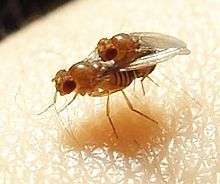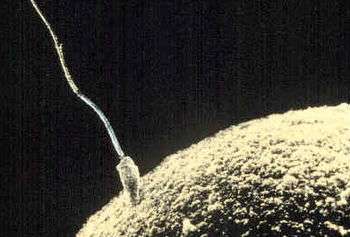Sexy son hypothesis


The sexy son hypothesis in evolutionary biology and sexual selection—proposed by Ronald Fisher in 1930—states that a female's ideal mate choice among potential mates is one whose genes will produce male offspring with the best chance of reproductive success and implies that a potential mate's capacity as a parental caregiver or any other direct benefits the father can offer the mother such as nuptial gifts, or good territory are irrelevant to his value as the potential father of the female's offspring. Fisher's principle means that the sex ratio (except in certain eusocial insects) is always 1:1 between males and females, yet what matters most are her "sexy sons"' future breeding successes, more likely if they have a promiscuous father, in creating large numbers of offspring carrying copies of her genes.[1] This sexual selection hypothesis has been researched in species such as the European pied flycatcher.[2]
Context
Female mating preferences are widely recognized as being responsible for the rapid and divergent evolution of male secondary sex characteristics.[3] In 1976, prior to Weatherhead and Robertson's paper,[4] Richard Dawkins had written in his book The Selfish Gene:
In a society where males compete with each other to be chosen as he-men by females, one of the best things a mother can do for her genes is to make a son who will turn out in his turn to be an attractive he-man. If she can ensure that her son is one of the fortunate few males who wins most of the copulations in the society when he grows up, she will have an enormous number of grandchildren. The result of this is that one of the most desirable qualities a male can have in the eyes of a female is, quite simply, sexual attractiveness itself.[5]
The sexy son hypothesis, published by Fisher in his book The Genetical Theory of Natural Selection, is one of several possible explanations for the highly diverse and often astonishing ornaments of animals.[6][7][8] If females choose physically attractive males, they will tend to get physically attractive sons, and, thus more grandchildren, because other choosy females will prefer their attractive, sexy sons. The theory will function regardless of the physical or behavioral trait a female chooses, as long as it is heritable (that is, the trait varies between individuals of the population), because it is possessing the trait that makes males attractive, and not the qualities of the trait in itself. Thus, traits culturally perceived as negative can still be seen as desirable; for example, females who stay with or are attracted to males they know to be disloyal in a monogamous relationship. If this trait is passed to any male children, they are more likely to themselves be non-monogamous, have several mates and spread the female's genes to multiple grandchildren.
Once a preference becomes established, females choosing males with elaborate secondary sexual traits will produce sons that carry alleles for the trait and daughters that carry alleles for the preference, generating genetic coupling that will drive self-reinforcing coevolution of both trait and preference, due to the mating advantage of males with the trait, creating a Fisherian runaway sexy sons process.[8] Similar models have been proposed for postcopulatory female preferences, such as the time at which females removed the male's sperm ampulla after mating. Sexual selection by direct and/or indirect benefits as well as sexual conflict determine the evolution of animal mating systems.[9]
In its original context, the "narrow-sense sexy son hypothesis" of Weatherhead and Robertson refers to mating systems with care from both parents. In these mating systems, females that mate with a polygynous male normally receive less assistance than females mated with a monogamous male,[10] and thus suffer from direct fitness consequences that have to be (at least) compensated for by the breeding successes of their sexy sons. On the other hand, a "broad-sense sexy son hypothesis" encompasses both polygyny and promiscuous mating systems, with and without care from both parents. Alatalo (1998)[11] argues that the costs of any additional choice may be so minor that female choice for honestly signaling males, that is good genes, may evolve even if the indirect benefits on offspring quality are small. A similar argument can be made for the sexy son hypothesis if mates of attractive males do not suffer any direct fitness consequences.[12]
Sexual conflict

.jpg)
Sexual conflict refers to the conflicting goals of breeding males and females. It describes the diverging interests of males and females in optimizing their fitness. From the viewpoint of any one partner, the best outcome would be for the partner's mate to care for the young, thus freeing up his or her own resources (e.g., time and energy) that s/he—but typically he—can invest in further sex that may create additional offspring. In polygynous mating systems, sexual conflict means the optimization of male reproductive success by having mated with multiple females, even though the reproductive success of a polygynously mated female is thereby reduced.[12] Such can be the case for the Guianan cock-of-the-rocks, whose male members spend a majority of their time and energy into maintaining their plumage and attempting to seek the most matings. Females on the other hand, spend their time building and maintaining their nest where they will lay their eggs and raise the young.
Good genes theory
"Good genes" theory proposes that females select males seen to have genetic advantages that increase offspring quality. Increased viability of offspring provides compensation for any lower reproductive success that results from their being "picky". The good-gene hypothesis for polyandry proposes that when females encounter better males than their previous mates, they re-mate in order to fertilize their eggs with the better male's sperm.[7]
Significant sire effects on egg to adult viability and son’s pre-productive survival, as well as moderate to high coefficients of additive genetic variation for these traits have been found in dung beetles.[13] Beetles who have selected mates with better genetics tend to have offspring that survive longer and are more able to reproduce than those that do not pick mates with genetic quality. This suggests that carefully choosing a mate is beneficial.[13]
Another study notes that pronghorn females engage in an obvious and energetically expensive mate sampling process to identify vigorous males. Though each female selects independently, the outcome is that a small proportion of the herd's males sire most young. Offspring of attractive males were more likely to survive to weaning and to age classes as late as 5 years, apparently due to faster growth rates.[14] Because pronghorn males do not have costly ornaments, the authors conclude that female choice for good genes can exist in the absence of obvious sexual selection cues such as elaborate antlers.
The sexy son hypothesis is closely related to the good genes assumption and the Fisherian runaway selection process. Like good genes, the sexy son hypothesis assumes the existence of indirect genetic benefits that are able to compensate any inferior direct reproductive success (i.e., fewer offspring). The main difference between good genes and the sexy son hypothesis is that the latter assumes an indirect effect due to the attractiveness of the sons, whereas good genes focus on the viability of both sons and daughters. However, "attractiveness" is not narrowly defined, and can refer to every trait that increases a male's probability to become polygynous.
Sperm models

Good-sperm models predict positive genetic associations between a male’s sperm competitiveness and the general viability of his offspring,[7] whereas sexy-sperm models predict that multiple mating females, where sperm competition occurs produce successful sons, and daughters who themselves incite sperm competition through multiple mating.[15][16] As with precopulatory processes, postcopulatory models predict that the trait in males that determines fertilization success will become genetically coupled with the mechanism by which females choose the sperm of preferred males.[17]
Human sexual activity
The sexy son hypothesis has also been put forward as the origin of some aspects of human sexual activity. In particular, it has been shown that, especially during the most fertile times of their menstrual cycles, human females are more attracted to more physically attractive men, and to men whose physical features are indicative of a higher exposure to testosterone during key developmental periods.[18] They are also more attracted to men with relatively feminine faces during the remainder of the cycle. However, the methodology of these claims is disputed.[19] These observations have led to the conclusion that infidelity is a natural occurrence in females, and evolutionarily advantageous, on the grounds that it will enable them to secure both the best genes and the best caregiver for their offspring.[20][21]
See also
- Sexual selection
- Mate choice
- Fisherian runaway
- Female promiscuity
- Sexual selection in human evolution
References
- ↑ Gwinner, H; Schwabl (2005). "Evidence for sexy sons in European starlings (Sturnus vulgaris)". Behavioral Ecology and Sociobiology. 58 (4): 375–382. doi:10.1007/s00265-005-0948-0.
- ↑ Weatherhead Patrick J., Robertson Raleigh J. (1979). "Offspring quality and the polygyny threshold: 'the sexy son hypothesis". The American Naturalist. 113 (2): 201–208. doi:10.1086/283379. JSTOR 2460199.
- ↑ Andersson M (1994). Sexual Selection. Princeton Univ Press, Princeton, NJ.
- ↑ Weatherhead PJ, Robertson RJ (Feb 1979). "Offspring quality and the polygyny threshold: 'The sexy son hypothesis'". Am. Nat. 113 (2): 201–8. doi:10.1086/283379.
- ↑ The Selfish Gene
- ↑ Geoffrey Miller (2000). The Mating Mind. Anchor Books, a division of Random House, Inc. (First Anchor Books Edition, April 2001). New York, NY. Anchor ISBN 0-385-49517-X
- 1 2 3 Yasui Y (1997). "A "Good-Sperm" model can explain the evolution of costly multiple mating by females". The American Naturalist. 149 (3): 573–584. doi:10.1086/286006.
- 1 2 Mead LS; Arnold SJ (2004). "Quantitative genetic models of sexual selection". Trends Ecol Evol. 19: 264–271. doi:10.1016/j.tree.2004.03.003.
- ↑ Andersson M.; Simmons L.W. (2006). "Sexual selection and mate choice". Trends Ecol. Evol. 21 (6): 296–302. doi:10.1016/j.tree.2006.03.015. PMID 16769428.
- ↑ Ligon JD. (1999). The evolution of avian breeding systems. New York: Oxford University Press.
- ↑ Alatalo R.V., (1998). Mate choice for offspring performance: major benefits or minor costs? Proc R Soc Lond B Biol Sci. vol 265, pp 2297-2297
- 1 2 Thomas Huk and Wolfgang Winkel, (2008). Testing the sexy son hypothesis—a research framework for empirical approaches. Behavioral Ecology (2008) vol 19, (2). pp 456-461. doi:10.1093/beheco/arm150. First published online: January 18, 2008. Institute of Avian Research "Vogelwarte Helgoland," An der Vogelwarte 21, D-26386 Wilhelmshaven, Germany. Address correspondence to T. Huk, who is now at Department of Business Administration, Economics, and Social Sciences, Technische Universität Braunschweig, Rebenring 58A, D-38106 Braunschweig, Germany.
- 1 2 Garcia-Gonzalez, F; Simmons. "Good Genes and Sexual Selection in Dung Beetles (Onthophagus taurus): Genetic Variance in Egg-to-Adult and Adult Viability". PLoS ONE. 6 (1): e16233. doi:10.1371/journal.pone.0016233.
- ↑ Byers John A.; Waits Lisette (2006). "Good genes sexual selection in nature". Proceedings of the National Academy of Sciences of the United States of America. 103 (44): 16343–1634. doi:10.1073/pnas.0608184103.
- ↑ Curtsinger J. W. (1991). "Sperm competition and the evolution of multiple mating". American Naturalist. 138: 93–102. doi:10.1086/285206.
- ↑ Keller L; Reeve H.K. (1995). "Why do females mate with multiple males? The sexually selected sperm hypothesis". Adv. Stud. Behav. 24: 291–315. doi:10.1016/s0065-3454(08)60397-6.
- ↑ Evans JP; Simmons LW (2007). "The genetic basis of traits regulating sperm competition and polyandry: can selection favour the evolution of good- and sexy-sperm?". Genetica. 134 (1): 5–19. doi:10.1007/s10709-007-9162-5. PMID 17619174.
- ↑ Evolution and Human Behavior, Volume 21, Issue 1, Pages 39-48 (January 2000),Female preference for male faces changes cyclically: Further evidence I.S Penton-Voak, Ph.D.a, D.I Perrett, Ph.D.a
- ↑ BBC NEWS | Science/Nature | Women's choice of men goes in cycles
- ↑ Evans JP; Simmons LW (Sep 2008). "The genetic basis of traits regulating sperm competition and polyandry: can selection favour the evolution of good- and sexy-sperm?". Genetica. 134 (1): 5–19. doi:10.1007/s10709-007-9162-5. PMID 17619174.
- ↑ Røed KH; Holand Ø; Mysterud A; Tverdal A; Kumpula J; Nieminen M (Mar 2007). "Male phenotypic quality influences offspring sex ratio in a polygynous ungulate". Proc. Biol. Sci. 274 (1610): 727–33. doi:10.1098/rspb.2006.0214. PMC 2197213
 . PMID 17254998.
. PMID 17254998.